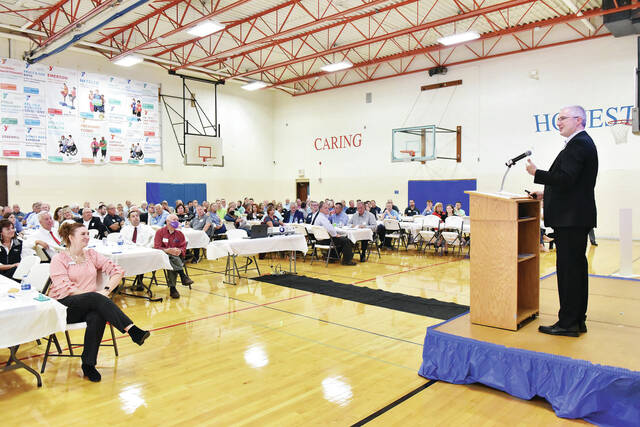
SIDNEY — The 33rd Annual Economic Outlook Luncheon had a unique tone, with the focus on COVID-19 cases impacting economic recovery, front and center.
“It has been an extraordinarily unusual time for everybody. It has been an extraordinarily unusual time for people who follow economic trends as well,” Richard Kaglic said.
Kaglic was the keynote speaker at the luncheon, sponsored by Wilson Health, the Shelby County Chamber of Commerce, and the Sidney Shelby County YMCA. He is the vice president and senior regional officer of the Cincinnati branch of the Federal Reserve Bank of Cleveland, but attended the luncheon independently to give his perspective of the current outlook of the economy to hundreds of area business leaders in attendance. According to Kaglic, while the economy continues to grow, the rate of growth has slowed due to the impact of COVID-19 last year and the current climb in COVID-19 cases.
“The recovery has been quite uneven across industry segments. It’s been uneven across the nation by geography — it’s uneven by metropolitan and urban splits. A lot of unevenness in the economy, and because of that, a lot of firms doing very well, and a lot firms continue to struggle,” Kaglic said.
According to Kaglic, while consumer spending on goods is up 15% compared to pre-pandemic numbers, the spending on services is down 3% compared to pre-pandemic numbers. While spending has been trending up since the economy reopened, the growth overall is weak. More recently, the rise in COVID-19 cases has cost the economy in terms of real spending.
“We continue to hear from restaurants that we speak to, that they have seen a down-tick in the number of seated diners. They are seeing a shift back out to take-out and delivery orders, but it’s not enough to overcome the lack of people sitting down and dining in restaurants,” Kaglic said.
The impact of shift to take-out over in-person dining, Kaglic said, impacts restaurants differently depending on their pre-pandemic service. Restaurants like McDonald’s that were already built to heavily accommodate take-out with drive thrus are going to see less impact than traditional white tablecloth, full service dining restaurants.
“Nobody pulls up to a curbside and orders a fine bottle of wine to go with their dinner,” Kaglic said. “Those restaurants are struggling more than lower-end shops set up specifically for take-out and delivery.”
The same impact is seen in other high-contact service industries, such as hotels. While people are still traveling for leisure and to get out of their homes, there is significantly less business travel since many businesses have shifted to a remote working model. While nothing has been derailed, the growth has slowed.
Kaglic also highlighted issues in supply chains in industries around the county, calling the disruptions severe, that worsen as COVID-19 cases rise.
“What often has happened throughout this pandemic is that, when COVID cases start to rise, we start to see an increase in worker absences in important points, including at ports or in logistic centers, which makes it very, very difficult for firms to move things around in the country, and it’s very difficult to sell things that you don’t actually have on your lots,” Kaglic said.
Currently, the automotive industry is experiencing a shortage in semiconductor chips for vehicles, which has halted production across the board and is expected to extend into 2022. The demand for vehicles is strong, but automotive dealers don’t have the vehicles to sell.
“Inventories are at one-third of where they were prior to the pandemic. It’s impossible to sell products that you don’t have,” Kaglic said.
On the other side of things, home sales skyrocketed during the pandemic due to the transition of more people working from home and seeking a place that offered dedicated office and gym spaces in-house. While the increase of home sales seems promising on the surface, Kaglic said that many realtors said that if there isn’t a strong return of job growth, housing sales could wane and that could create problems further down the line.
“The builders and realtors that we talk to are telling us, people are coming in and they want to buy homes, it’s difficult to find the dwelling that buyers want,” Kaglic said.
One of the most prevalent issues that business owners have dealt with since the economy reopened has been filling open positions. At the start of the pandemic, nearly 23 million jobs were shed across the country as businesses deemed non-essential were shut down. Comparatively, 8.8 million jobs were lost during the Great Recession of 2008. Currently, while there is steady job growth, only 17 million jobs have been recaptured. In Ohio, employment recovery is off by 4.7% compared to February 2020.
“If we break job recovery down by occupational categories (…) hourly workers were very hard hit by this economic downturn. Many of these jobs are going to be in frontline, service-providing sectors, such as the restaurants, the hotels, the retail stores and the like,” Kaglic said.
Kaglic echoed that the economy is still growing, despite it growing at a slower pace, and that it is believed that the rise in COVID-19 cases is impacting economic activity, and not in a good way.
“It’s going to be enough to slow growth, but not enough to derail recovery. We will continue to see an increase, and we expect to see strong job growth,” Kaglic said.


